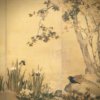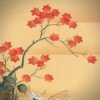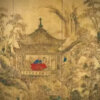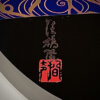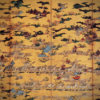Kimura Buzan: One of the Big 4 in the Nihon Bijutsuin. The Best Colorists in the Nihon Bijutsuin.
Contents
Life
Kimura Buzan was born in Ibaraki Prefecture in 1876. It is said that Buzan already had an interest in painting at an early age, and from he was three years old, he learned painting under a local painter, Sakurai Karyō. It is said that he had already used the name “Buzan” at that time. After graduating from elementary school, he moved to Tokyo and entered junior high school, but around this time he was studying at Tenshinsha, a painting school of Kawabata Gyokushō. In 1891, at the age of 16, he entered the Tokyo Art School, and in the following year, he entered the Painting Department. The Tokyo Art School had just opened in 1890 and was in its third year of operation, and there were his senior students including Yokoyama Taikan, Shimomura Kanzan, and Hishida Shunsō. The future big four in the Nihonbijutsuin, under Okakura Tenshin, were all here. He graduated from the Art School in 1896. His graduation work is “The Emperor Takakura’s Trip to Itsukushima,” and he entered the Japanese Painting Department. In September of the same year, he exhibited his work at the first Kyōshinkai exhibition of the Japan Painting Association and received a second prize. The following year, he received the first prize at the third exhibition and was beginning to make his mark as a pupil of Okakura Tenshin. In the same year, the restoration team for the Hiraizumi Chūsonji Golden Hall was organized at the Tokyo Art School, and Buzan followed his seniors and participated as an assistant. It can be said that he gained sufficient knowledge about Buddhist art and was able to form the basis of Buddhist painter Buzan in later years. In 1898, when Buzan was 23 years old, the famous “Tokyo Art School Riot” happened, and the principal, Okakura Tenshin resigned. Following Tenshin, 16 people including Hashimoto Gahō, Yokoyama Taikan, Hishida Shunsō, and Terasaki Kōgyō resigned, and Buzan joined Taikan and others. Tenshin immediately founded the Nihonbijutsuin with his comrades and launched a new art movement. As an associate member, Buzan followed Tenshin’s guidance and greatly improved his painting skills. He exhibited a large number of works at each exhibition, and received guidance from Tenshin through study groups and painting competitions, and gradually became well known in the art world. The Nihonbijutsuin was very active, holding exhibitions throughout Japan and abroad. However, due to economic pressures, the Nihonbijutsuin was moved to Izura in Ibaraki Prefecture, and Tenshin, Yokoyama Taikan, Hishida Shunsō, Shimomura Kanzan, and others moved to Izura with their families. Buzan also moved to Izura with his wife and children. The four, Taikan, Shunsō, Kanzan, and Buzan spent a life of poverty in Izura while making effort hard together. In 1907, the first Bunten exhibition was held and Buzan exhibited his masterpiece “Abō Bonfire” and won the third prize.
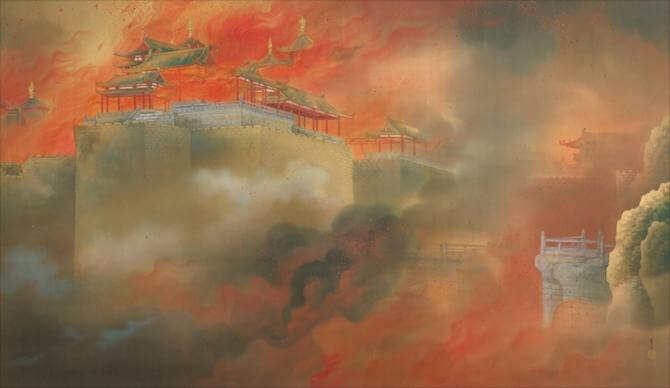
In 1914, on the occasion of the first anniversary of Tenshin’s death, the Nihonbijutsuin was rebuilt with Taikan as the center. Buzan also joined the management of the Academy as a founding colleague. Since then, he has been active as a core member of the revived Nihonbijutsuin and as a major figure in the world of Japanese paintings, and he died in 1942 at the age of 66. He was active as a painter in the modernization of Japanese paintings in the Meiji, Taishō, and Shōwa periods.
Buzan’s works in his early period, starting with “The Emperor Takakura’s Trip to Itsukushima,” his graduation work from the Tokyo Art School, and ending with “Abō Bonfire” at the first Bunten exhibition, were mostly historical paintings. At this time, historical paintings were generally popular due to the trend of the times, and many of Buzan’s works were also historical paintings. However, there are very few works by Buzan from this period that can be seen today, and the only way to judge them is by their titles. This was also the time when he was studying hard at the Nihonbijutsuin, along with Taikan, Shunsō, Kanzan, and others. In the Taishō period, Buzan’s middle period was a time when he worked to manage the revived Nihonbijutsuin. During the Taishō period, he painted relatively more flower and bird paintings. He began to paint less historical paintings which he painted earlier and more Buddhist paintings. Besides, in his latter period, from the Shōwa period, he painted almost all Buddhist paintings, and it can be said that the image of the Buddhist painter Kimura Buzan was formed around this time.
Autumn Colors

This painting, entitled “Autumn Colors,” depicting autumn flowers and plants with the light brushstrokes of Buzan, who was skilled at coloring, allows us to fully enjoy the autumn atmosphere. The painting technique, the so-called Rinpa school of flower and bird paintings, has been attempted in many modern flower and bird paintings, and Buzan is probably one of them. This painting is filled with plants and flowers symbolizing autumn, but the main focuses are on hibiscuses with their beautiful light red flowers and chrysanthemums with their white flowers. In addition, ivy leaves with red leaves are effectively added in the painting. Besides, there are many other plants, including one of the seven autumn herbs, Ominaeshi, pampas grass, Sanguisorba, Kumazasa, Fern, and others are drawn in a sloppy manner, and it is exactly autumn. The contrast between the gorgeously colored flowers and the silhouetted plants and flowers gives this painting depth. This is a flower-and-bird painting by the experienced artist Buzan.
Late Autumn

At the age of 16, Kimura Buzan studied at Kawabata Gyokusho’s art school. In 1896, he graduated from the Tokyo Art School, and in September of the same year, he exhibited his work at the Japan painting Association Exhibition, for which he received a second prize. It was an advance into the art world at the age of 21. He becomes a deputy member of the Nihonbijutsuin, which was founded in 1898. In 1906, the Nihonbijutsuin moved to Izura, Ibaraki Prefecture, and Buzan went to work with Yokoyama Taikan, Hishida Shunsō, and Shimomura Kanzan. In the first Bunten exhibition held in the following year, Buzan made a good showing by exhibited his masterpiece “Abō Bonfire” and winning the third prize. In 1914, the Nihonbijutsuin was rebuilt, and as a member of the academy, he exhibited “Late Autumn”, a pair of six-panel gold screens, at its first exhibition. This work was exhibited by Buzan, who was known as a colorist, with full satisfaction at the Inten exhibition, which was held to compete with the Bunten exhibition. The subject of the painting is the atmosphere of an autumn day in a familiar garden. A persimmon tree, bathed in the autumn light, is hanging down its heavy branches, which are full of fruit. The sunflower which had bloomed, is leaning its head full of seeds under the persimmon tree along with the movement of the sun on a summer’s day, as if to take over the leading role. Instead of sunflowers, the Hageitō with red-dyed leaf is confused by the conspicuousness of the leading role in the sunny weather. On the left side, the tips of persimmon branches are growing, and there is a bamboo grove of female bamboos that are poking straight up from the open ground in the garden, and chestnuts hang down their tips and flutter to the left. Hageitō is also fluttering in the same way. If you look closely, you can see a brown bird under the stalk of the Hageitō on the right side, as if it is coveting a ripe persimmon. A small bird also perches on a persimmon twig on the left side with a straight face. Autumn is quietly deepening in the autumn sunshine. From this painting, Buzan’s enthusiasm for the Inten exhibition can be felt. By the way, Buzan’s coloring is outstanding. It is rare for an artist to depict the autumnal atmosphere with such gorgeous colors. In a picture in which red is dominant, the leaves of the female bamboo and the green of the remnants of the sunflower still remaining are very effective.
Noonday
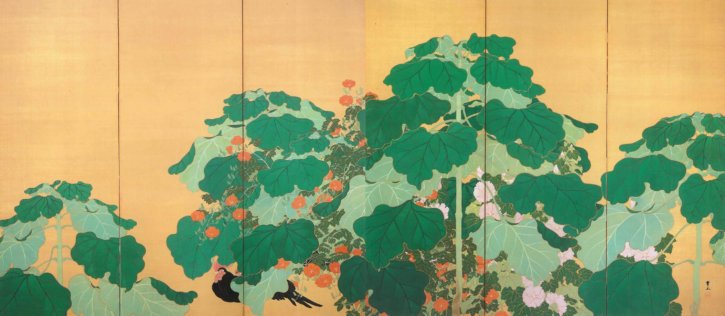
On an afternoon when the summer sun shines, a young paulownia tree energetically piles up leaves and spreads to create a shade of green. In the shade, a black chicken guard is resting. Its black feathers and red crest look even hotter in the summer sun. If “Late Autumn” is a scene of a garden under the autumn sun, this expresses a scene of a garden on a midsummer afternoon. The young paulownia leaves are spread out and look cool, even in the scorching sun of summer. In actuality, it would be rare to see a group of nearly ten young paulownia trees like this in a garden, but that can be said as artistic taste. The greenish-blue leaves of the paulownia trees arranged in the large picture screen show beautiful composition. We can see Buzan’s rich sense of color, which fully takes into account the gold background. The young paulownia tree has orange flowers of the Chinese trumpet vine. This poisonous flower is beautiful among the green paulownia leaves. The paulownia leaves are trimmed with gold mud, and the veins of the leaves of the Chinese trumpet vine and hollyhock are painted with gold mud. The almost white flowers of the hollyhock look neat and clean compared to the almost vermilion color of the Chinese trumpet vine. Male and female black chickens resting in the shade under the green in the summer sun. The decorative beauty of the colors, based on the sketching, with the large screen of the folding screen, save the viewer from the heat of midsummer for a while.
Buzan’s flower and bird paintings began around the age of 25 and continued until his later years. He had excellent skills in both Buddhist painting and flower and bird paintings. Above all, people who see Buzan’s paintings are attracted by his vivid colors.
In his paintings of flowers and birds, Buzan did not use a wide variety of flowers, trees, plants, birds, and animals to create a spectacular effect. Rather, it could be an unnamed flower in a garden, a paulownia leaf, or even a single chrysanthemum, all of which, under Buzan’s brush, would appear in the style of a modern Ogata Kōrin. Buzan was a magician of colors.
The White Chrysanthemum Picture

Kimura Buzan died in Tokyo in 1942 at the age of 67. From around 1935, he had been devoting himself to painting the interior of the Dainichi Hall in his birthplace in Kasama City, Ibaraki Prefecture, but at the time of his death, only a few ceiling paintings remained unfinished. This was the last work of Buzan, who was known as a colorist. Prior to painting the interior of Dainichi Hall in his birthplace, he spent three years from 1932 painting the Kōyasan Kondō Mural Painting. The last ten years of Buzan’s life were spent painting and decorating the walls of Buddhist temples. This may have been the culmination of Buzan’s painting techniques, which he had used in various flower and bird paintings and Buddhist paintings since his youth.
The “White Chrysanthemums Picture” folding screen is thought to have been created between 1917 and 1918. This was when Buzan was 42-3 years old. He participated in three or four exhibitions of the Saikōinten, and even though he was said to be a precocious artist, he was at his most productive at that time.
The “White Chrysanthemums picture” is a community of white chrysanthemums that overlap and compete on the screen of the gold ground of six songs and one pair. The bamboo fence is arranged in a neat horizontal line, and the blue watering is flowing slowly in a curved line. The leaves of the white chrysanthemums are richly decorated with varying tones of greenish-blue. As we have already seen in “Late Autumn” and “Noonday,” there are white chrysanthemums only, but the effect of the gold ground, the blue flowing water, the greenish-blue chrysanthemum leaves, and the white chrysanthemum flowers show the unique painting technique and skill of Buzan. In Buddhist paintings, Buzan also revealed a new world, in his flower-and-bird paintings on folding screens, painted between 1914 and 1917-8, he showed a type of modern flower-and-bird paintings.
Chrysanthemum
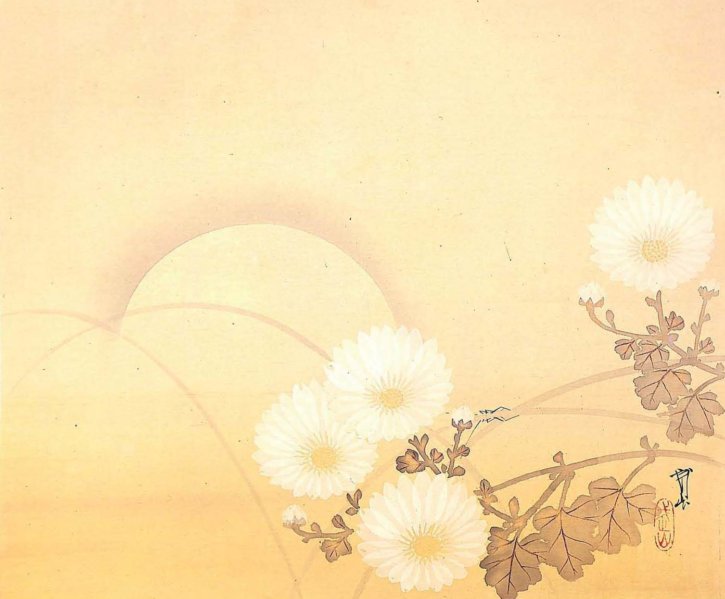
Autumn Scenery
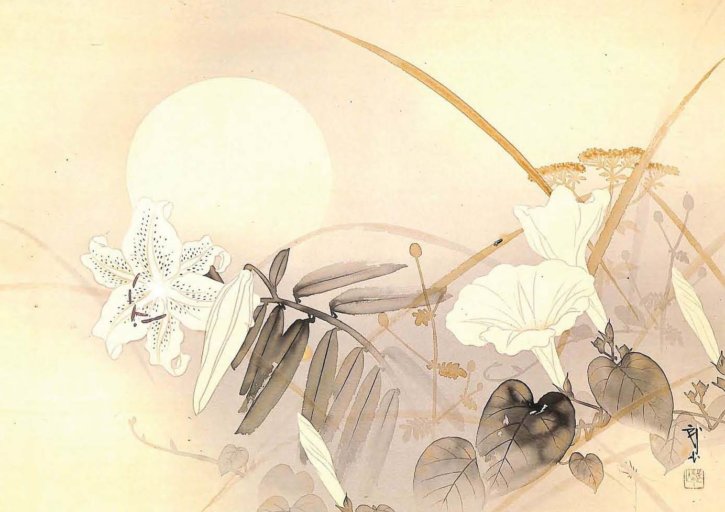
Sparrow in Plum
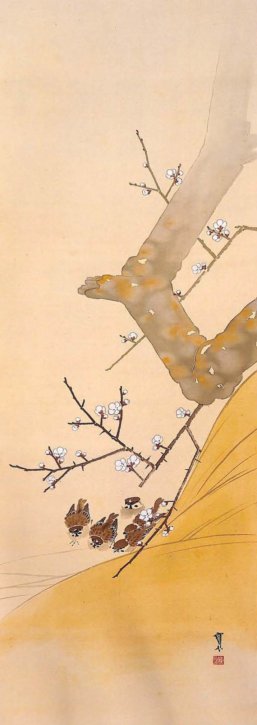
Peony
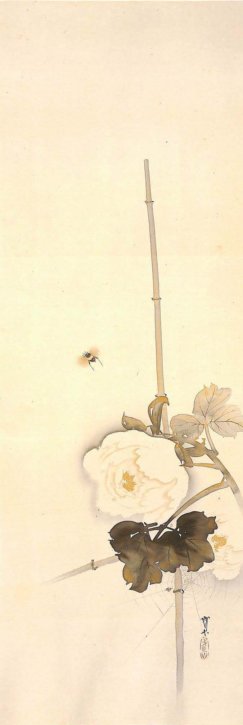
The Seven Grasses

Kimura Buzan was one of the leading painters of the Nihonbijutsuin, specializing in flower and bird paintings as well as religious paintings. There are many works that brilliantly depict decorative flowers and birds on both sides of the large screen which is called as the six songs and one pair, but also drew many gorgeous and elegant bird-and-flower paintings by making full use of the natural artistic talent mainly on flowers on the hanging scroll. Although Buzan was praised as a rare painter of color, it seems that he drew flowers with his heart, the same as drawing religious paintings. If he had chosen Buddha as his subject, his paintings would have been excellent Buddhist paintings, and if he had chosen flowers and grasses blooming in the autumn countryside, his paintings would have been excellent flower and bird paintings. It seems that he discovered Buddha-nature and drew his heart, from all kinds of forests to one tree and one grass.
“Chrysanthemums” is almost like an ink painting, and is drawn on ink, whitewash, and other with a small amount of gold paint. This painting gives us a taste of the long autumn night. White chrysanthemum flowers floating in the moonlight in mid-autumn, chrysanthemum leaves and Japanese pampas grass that grows like a bow that look like a black silhouette, and bell crickets in the Japanese pampas grass show only limbs and antennae. The bell crickets are probably chirping through the long autumn night, receiving the moonlight. In the picture made by the traditional *mokkotsu technique, the chrysanthemum leaves are painted in thin ink with a little gold paint and the veins of the leaves are blackened. The petals are carefully layered in whitewash, and the graceful atmosphere is unique to Buzan.
- Mokkotsu: A technique where the object is expressed by the shading of sumi ink or color rather than by using outlines (koppō.) It is widely known as a technique for kachō-ga (paintings of flowers and birds).
“Autumn Scenery” is thought to be created around 1941, the last year of Buzan’s life. The painting depicts a scene of a field with autumn flowers and grasses, just as the full moon of mid-autumn is about to rise. Using ink and gold paint, which Buzan is good at in bird-and-flower paintings, he paints autumn flowers such as Ominaeshi, Sanguisorba officinalis, and Japanese pampas grass in a silhouette style. The moonlight of mid-autumn shines brightly, stealing away the pale red of the lilies, and the flowers and buds of the evening glory are becoming whiter. A firefly is glowing on a silver grass, and a bell cricket is chirping in the shadow of the leaves to the end of its short life. Most paintings of autumn flowers and plants depict the atmosphere of the autumn sunshine, but this painting by Buzan is a rare example of an autumn scene at night. This picture is a unique autumn view, where the white flowers of lilies and evening glories, boldly arranged in the moonlight of a moonlit night, and the things that shine and cast shadows in the moon’s glow, are drawn symmetrically using gold and ink. Buzan, who was a genius at coloring, also painted more than five colors (“Ink has five colors” means that black ink can be made to feel various shades by properly using the amount and type of water. It has been said since ancient time) in his ink paintings.
Although “Sparrow in Plum” is a spring work, but this painting depicts five sparrows on an old white plum tree instead of warblers on plum blossoms. In the foreground, there is a large overhanging clay pot, and an old plum tree, covered with light ink and gold paint, is protruding in the shape of a right angle, from whose trunk a branch with white flowers is growing. The surface of the water is covered with thin ice, and Sparrows are taking the form of bathing, pushing the coldness. The cold plum blossoms are blooming in the cold, but the sound of spring is approaching.
In the “Peony,” peonies with large flowers supported by bamboos are painted using only ink and gold paint. The leaves of the peonies, which are painted in different shades of black ink, and the accompanying bamboo are painted by tarashikomi technique with gold paint. From the white flowers of the peony, a canary flies away and a spider builds a web below. This painting depicts a summer scene in ink and water, and the brushstrokes are generous, showing Buzan’s mastery of flower-and-bird painting.
“The Seven Grasses” is an autumn-colored painting that depicts autumn plants and flowers shining in the bright autumn sunlight on a vertical screen. The white tips of the light grasses are swaying in the autumn breeze. The pale yellow umbrella-shaped flowers of ominaeshi appear to shine golden on an autumn day. The light reddish-purple flowers of the Fujihakama are competing with each other to bloom against the sky. In addition to the seven autumnal flowers, the painting also depicts waremokō and autumn leaves. The red color of the autumn leaves is gorgeous in the golden autumn colors. The golden rays of the autumn sun can turn the leaves golden as well. When the wind blows, the world of colors turns dark. This is the natural order of things. In the short time until then, the plants and flowers were bathed in the autumn light and were in autumn colors. This may be seen as a picture of the pure land of the heart for Buzan.

